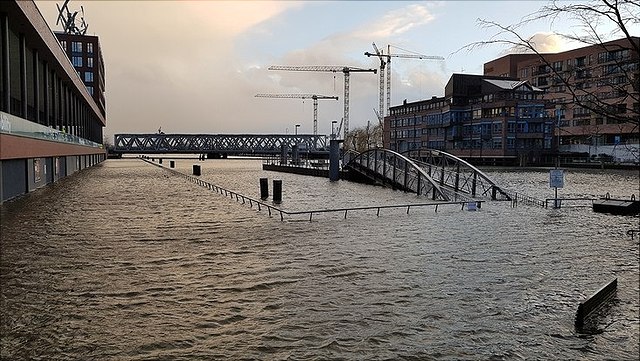What to do with the water? – it’s up to Hamburg

The citizens of Hamburg love the water – but also fear it. After all, it threatens the city in four different ways: heavy rains, rising groundwater, inland flooding, and storm surges can leading to heavy floods, and climate change is worsening that threat. There’s only one thing for it: bringing together all available know-how, finding new ideas, and making lasting changes to the city. Researchers from the University of Hamburg, together with academic partners and experts from the field, are now investigating what Hamburg could look like in 2050 in an interdisciplinary project. Doing so requires a fair amount of mental gymnastics: cities are complex systems in which everything is connected in one way or another, which means there are countless aspects to consider when looking for new solutions – like how much of the city’s surface is sealed, how income is distributed, how decisions on climate measures are made, and which laws influence the city’s development.
To introduce a bit of order in this quagmire, the researchers have essentially created a city map showing the most important interconnections. Workshops with government authorities, offices and companies are intended to gather complementary practical expertise. In the next step, bold and original ideas are called for: what “levers” could we pull to achieve a fundamental change? Which measures would be the most effective? And how many of them are actually feasible? One possibility: instead of continuing to dredge out the Elbe to make it deeper, relocating the harbor to the mouth of the Elbe and then using the former harbor area for housing and research. Or reducing the height of Hamburg’s dikes to give the river more room to expand. Also, more education – say, in the form of creative projects – could be an effective option. But one thing is clear: what happens next is up to the city and the people living in it, giving them the chance to shape their future with the water.
More information
Project partners
HafenCity University Hamburg
Hamburg University of Technology
Helmholtz Centre Hereon
Climate Service Center Germany (GERICS), Helmholtz Centre Hereon
Federal Waterways Engineering and Research Institute (BAW)
Project website
C1 - Sustainable Adaptation Scenarios for Urban Areas – Water from Four Sides
Related articles
Adapting to Climate Change: Cities will have to fundamentally transform
Hamburger Abendblatt: Cities will have to fundamentally transform (ger)
Warning, flood risk: Where citizens of Hamburg need more support
Hamburger Abendblatt: Warning, flood risk: Where citizens of Hamburg need more support (ger)
Since 2019, through Germany’s Excellence Strategy the project has received funding from the German Research Foundation (DFG) as the University of Hamburg’s Cluster of Excellence for climate research “CLICCS – Climate, Climatic Change, and Society.” Hamburg’s Center for Earth System Research and Sustainability (CEN) coordinates the CLICCS program in close cooperation with the project partners.
